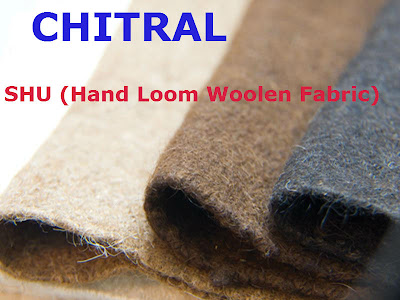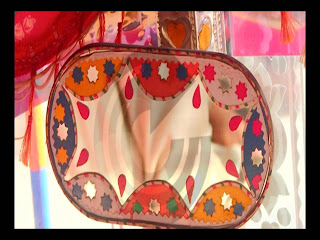Shu is a major product of the cottage industry in chitral Shu is also called Patti. It is a hand-spun, hand-woven, hand-loom fabric made of sheep’s wool. The wool used to make Shu can be knitted, woven into a fabric or used for embroidery and embellishment.
Shu is usually produced in lengths of 20 yards and between 12 to 14 inches wide. It comes in natural shades of white, gray, black and brown, and the distinctive walnut-dyed, red. The fabric is felted after weaving which ensures that as well as being light and warm, it is also wind-proof.
Because of its purely natural and organic origins It is highly in demand, not only in Pakistan but in entire world' Shu's products are used in various forms. Knitted items includes hats, coats, bags, gloves, socks, shawls, blankets,gowns, stoles, sweaters, vests, and ponchos.
Shu has a rich background of indigenous knowledge and skill in every stage of its production Shu has a rugged texture, and a unique look and feel, there will always be a difference in the shade of each individual item. There are many women involved from all over Chitral in the Shu sector and women artisans are playings a vital role in making of Shu.
In the remote past it was one of the basic needs of the people for making garments and quilts. Some of the early products of this handicraft was Zhil (quilt) and paitawa (wrapper on legs). Then long shirts named raghz were introduced. With the passage of time the skilled hands of Chitral women began to make more varieties. All these garments were made of Shu and every household used to be self sufficient in making these types of clothings. Large white blankets called Thakht were gifted to brides at the time of wedding.
There are many phases of making of SHU. Wool is the basic ingredient in the making of Shu. It is obtained from the backs of the small, local and unique breed of sheep in Chitral called Kailey.
A tool called a Sareel is used to shear the hair from the back of the sheep in a very traditional manner. This shearing process is called Brainik.
The wool is normally available in four natural colors: black, white, grey and brown. A reddish color is achieved by dying the wool in walnut hulls. Walnut dyeing is called Roik.
There is a moisture and grease in the wool when it is obtained from the sheep, a fine quality of white soil called Puchuti is mixed with the wool before carding which removes the moisture from the wool and allows the fiber to be separated.
After carding, the wool is distributed among the women members of the family for teasing. A handful of wool is called Dappi when it is in the process of teasing. After finishing these are passed on to the spinner.
Women spin the wool on a spinning wheel. Thread for Shu is made in two varieties. The single-ply thread for warp is called Tone.
Wore is rolled on a Thasurak by the spinner, ready for weaving. Thasurak Daru is a bobbin. It is an 8-10 long hollow piece of wood with a 1/4 diameter. It is used to hold rolls of single-ply thread in the boat shuttle for weaving.
Maku is an oval-shaped wooden boat shuttle, with sharp edges at both ends. It has an empty abdomen with holes to facilitate the fitting of the thasurak inside. It has a hole for the passage of thread. The weaver rotates it left to right for weaving. Maku is the most delicate and beautiful piece among the spinning and weaving tools. Tone is kept in Phani, a large cone-shaped ball wrapped onto a stick until it is rolled as a thread ball called Pindalu. Beaming/warping- the weaving preparation process before warping the thread through the heddle of the loom so that the threads do not tangle.The tone is warped on the heddle of the hand loom by the spinner or a skilled woman.
Weaving is always done by a man. He processes the wool on a handloom. The best quality of Shu in Chitral is called Moghekan
After weaving, the Shu is washed. It is felted in hot spring water (Garam Chashma), where it is washed and beaten with a stick to make the fibers cling together and produce a wind proof finished fabric.
After washing, the Shu is twisted around a wooden rod which is fixed into a stone wall. The other end of the rod, which is not attached to anything, is turned around to squeeze all the excess water from the material.
Calendaring is done to pull the wool into shape while it is still wet. Shu is dried by hanging it from the trees, or laying it across flat rocks, stone walls or anywhere else that is available. The Shu is then rolled up
W-11 is famous mini bus of karachi called the King of Karachi Roads.No one can beat these buses in art, craft decoration. It has out Standing Decoration.



























